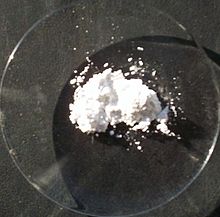Ytterbium(III) oxide
 From Wikipedia the free encyclopedia
From Wikipedia the free encyclopedia
 | |
| Names | |
|---|---|
| IUPAC name Ytterbium(III) oxide. | |
| Other names Ytterbia diytterbium trioxide ytterbium sesquioxide | |
| Identifiers | |
| ChemSpider | |
| ECHA InfoCard | 100.013.850 |
| EC Number |
|
PubChem CID | |
| UNII | |
CompTox Dashboard (EPA) | |
| Properties | |
| Yb2O3 | |
| Molar mass | 394.08 g/mol |
| Appearance | White solid. |
| Density | 9.17 g/cm3, solid. |
| Melting point | 2,355 °C (4,271 °F; 2,628 K) |
| Boiling point | 4,070 °C (7,360 °F; 4,340 K) |
| Insoluble | |
| Structure | |
| Cubic, cI80 | |
| Ia-3, No. 206 | |
| Octahedral | |
| Thermochemistry | |
Std molar entropy (S⦵298) | 133.05 J/mol·K [1] |
Std enthalpy of formation (ΔfH⦵298) | -1814.600 kJ/mol [1] |
Gibbs free energy (ΔfG⦵) | -1726.844 kJ/mol [1] |
| Hazards | |
| GHS labelling: | |
 | |
| Warning | |
| H315, H319, H335 | |
| P261, P305+P351+P338[2] | |
| NFPA 704 (fire diamond) | |
| Flash point | Non-flammable. |
| Related compounds | |
Other anions | Ytterbium(III) sulfide, Ytterbium(III) chloride |
Other cations | Thulium(III) oxide Lutetium(III) oxide |
Except where otherwise noted, data are given for materials in their standard state (at 25 °C [77 °F], 100 kPa). | |
Ytterbium(III) oxide is the chemical compound with the formula Yb2O3. It is one of the more commonly encountered compounds of ytterbium. It occurs naturally in trace amounts in the mineral gadolinite. It was first isolated from this in 1878 by Jean Charles Galissard de Marignac.[3]
Preparation[edit]
Ytterbium(III) oxide can be obtained by directly reacting ytterbium with oxygen:[4]
- 4 Yb + 3 O2 → 2 Yb2O3
It can also be obtained by the thermal decomposition of ytterbium carbonate or ytterbium oxalate at temperatures around 700 °C:[5]
- Yb2(CO3)3 → Yb2O3 + 3CO2
- Yb2(C2O4)3 → Yb2O3 + 3 CO2 + 3CO
Properties[edit]
Chemical[edit]
Ytterbium(III) oxide is a white powder.[2] It reacts with carbon tetrachloride[6] or hot hydrochloric acid to form ytterbium(III) chloride:[7]
- 2 Yb2O3 + 3 CCl4 → 4 YbCl3 + 3 CO2
- Yb2O3 + 6 HCl → 2 YbCl3 + 3 H2O
Physical[edit]
Like the other trivalent oxides of the heavier lanthanides, ytterbium(III) oxide has the "rare-earth C-type sesquioxide" structure which is related to the fluorite structure with one quarter of the anions removed, leading to ytterbium atoms in two different six coordinate (non-octahedral) environments.[8]
Uses[edit]
- Colorant for glasses and enamels
- Dopant for garnet crystals in lasers
- Optical fibers
- Additive for special alloys and dielectric ceramic materials[9]
See also[edit]
References[edit]
- ^ a b c R. Robie, B. Hemingway, and J. Fisher, “Thermodynamic Properties of Minerals and Related Substances at 298.15K and 1bar Pressure and at Higher Temperatures,” US Geol. Surv., vol. 1452, 1978.[1]
- ^ a b Sigma Aldrich; rev. 2012-09-19
- ^ Krebs, Robert E.; Déjur, Rae (2006). The history and use of our earth's chemical elements: a reference guide (2nd ed.). Westport, Conn.: Greenwood Press. ISBN 978-0-313-33438-2.
- ^ Wiberg, Egon; Wiberg, Nils (2007). Holleman, Arnold F.; Fischer, Gerd (eds.). Lehrbuch der anorganischen Chemie (102., stark umgearbeitete und verbesserte Auflage ed.). Berlin New York: Walter de Gruyter. ISBN 978-3-11-017770-1.
- ^ Meyer, Gerd, ed. (1991). Synthesis of lanthanide and actinide compounds. Topics in f element chemistry. Dordrecht: Kluwer. ISBN 978-0-7923-1018-1.
- ^ GORYUSHKIN, V. F.; ASTAKHOVA, I. S.; POSHEVNEVA, A. I.; ZALYMOVA, S. A. (1989-12-19). "ChemInform Abstract: Crystalline Holmium Dichloride". ChemInform. 20 (51). doi:10.1002/chin.198951025. ISSN 0931-7597.
- ^ Sebastian, Jörg; Seifert, Hans-Joachim (1998-09-07). "Ternary chlorides in the systems ACl/YbCl3 (A=Cs,Rb,K)". Thermochimica Acta. 318 (1): 29–37. doi:10.1016/S0040-6031(98)00326-8. ISSN 0040-6031.
- ^ Wells, Alexander Frank (1991). Structural inorganic chemistry. Oxford science publications (5th ed.). Oxford: Clarendon press. ISBN 978-0-19-855370-0.
- ^ Milne, G. W. A. (2005-09-02). Gardner's Commercially Important Chemicals: Synonyms, Trade Names, and Properties. John Wiley & Sons. ISBN 978-0-471-73661-5.
